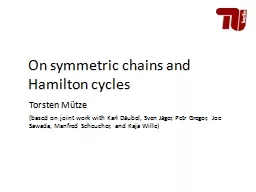

joint work with Karl Däubel Sven Jäger Petr Gregor Joe Sawada Manfred Scheucher and Kaja Wille On symmetric chains and Hamilton cycles The Boolean lattice ID: 793902
Download The PPT/PDF document "Torsten Mütze ( based on" is the property of its rightful owner. Permission is granted to download and print the materials on this web site for personal, non-commercial use only, and to display it on your personal computer provided you do not modify the materials and that you retain all copyright notices contained in the materials. By downloading content from our website, you accept the terms of this agreement.
Slide1
Torsten Mütze(based on joint work with Karl Däubel, Sven Jäger, Petr Gregor, Joe Sawada, Manfred Scheucher, and Kaja Wille)
On symmetric chains and Hamilton cycles
Slide2The Boolean lattice
consider
all
subsets
of
ordered
by inclusion
4-cube
a
fundamental and widely studied poset
its
size is
called
-
cube
-th
level
:= all
subsets of cardinality
Slide3The Boolean lattice
consider
all
subsets
of
ordered
by inclusion
even
odd
middle
level
(s)
a
fundamental and
widely
studied
poset
its
size
is
called
-
cube
-th
level
:= all
subsets
of
cardinality
Slide4Chain decompositions
Theorem
[
Sperner
28]
:
The width (=size of a maximum
antichain) of the -cube is
given by the size of its middle level(s) .
Theorem
[
Dilworth 50]:Any poset can be decomposedinto many
chains.
4-cube
chain
decomposition
Slide5Symmetric chain decompositions
useful
for
applications
:
symmetric
chains
,
i.e
.,
if
a
chain
starts
at level , then it ends at level .
(SCD)
symmetric
chain
decomposition
known
constructions
of
SCDs
for
the
-cube
due to[De Bruijn, van Ebbenhorst Tengbergen, Kruiswijk 51], [Lewin 72], [Aigner 73], [White and Williamson 77], [Greene, Kleitman 76]all constructions yield the same SCD
not
symmetric
4-cube
Slide6Parenthesis matching
useful
for
applications
: symmetric chains, i.e., if a chain starts at level ,
then it ends at
level .
‚parenthesis matching‘
description
by [Greene, Kleitman 76]
1001100100
10011
1
0100
10011101
1
0
100111011
1
0
001100100
known
constructions
of
SCDs
for
the
-cube
due
to
[De
Bruijn
, van Ebbenhorst Tengbergen, Kruiswijk
51], [Lewin 72], [Aigner 73], [White and Williamson 77], [Greene, Kleitman 76]
all
constructions
yield the same
SCD
Slide7Edge-disjoint
and orthogonal SCDs
Question
:
Are
there
other
constructions?
4-cube
Definition:
T
wo
SCDs
are
edge-disjoint
,
if
they
do not
share
any
edges
4-cube
Definition:
T
wo
SCDs
are
orthogonal
,
if
any
two
chains
intersect
in at
most
one
element
,
except
the
two
longest
chains
that
may
only
intersect
in and
Observe
:
orthogonal
edge-disjoint
Slide8even
Edge-disjoint
and orthogonal
SCDs
Question
:
How
many
pairwise
edge-disjoint
/orthogonal
SCDs
can
we
hope for?
is
an
upper
bound
:
Conjecture
[Shearer,
Kleitman
79]
: The -cube has pairwise orthogonal SCDs.
every
SCD
uses exactly
one of those edges
Theorem
[Shearer,
Kleitman 79]: The standard
construction and its complements
are two
orthogonal SCDs.
Theorem
[Spink
17]: The -cube has three
pairwise orthogonal SCDs for
.
Slide9Our results
Theorem 1:
The
-cube
has
four
pw. orthogonal SCDs for .
Theorem 2:
The
-cube has five pw. edge-disjoint SCDs for .
Proof
of Theorem 2:
Proof of Theorem 1:
Product
lemma
:
If the -cube
and -cube have edge-disjoint SCDs each, then the -cube has edge-disjoint SCDs.
find
five
edge-disjoint
SCDs
for
dimensions
and
Fact
:
If
and
are coprime, then every is a non-negative integer multiple of and .similar, but more complicated product lemma due to [Spink 17]
find
four orthogonal SCDs for dimensions and
computer search in the necklace
poset
Slide10The
central
levels
problem
-cube
Middle
levels
conjecture
:
The
subgraph
of the
-cube
induced
by
the
middle
two
levels
and has a Hamilton
cycle
.
Central
levels
co
njecture
:
The
subgraph
of the
-cube
induced
by
the
middle
levels
has a Hamilton
cycle
for
any
.
answered
positively
in
[M. 16]
raised
by
[
Savage
93], [
Gregor
,
Škrekovski
10], [
Shen
, Williams
15]
problem
with
a
long
history
Slide11The
central
levels
problem
[M. 16]
[Gray 53]
[
El-
Hashash
, Hassan 01], [Locke, Stong 03]
[
Gregor
, Škrekovski 10]
???
-cube
known
results:
Central
levels
co
njecture
:
The
subgraph
of the
-cube
induced
by
the
middle
levels
has a Hamilton
cycle
for
any
.
Slide12Theorem 4:The -cube has a cycle factor through the middle levelsfor all and .
Our
results
Theorem
3:
The
-cube
has
a
Hamilton
cycle
through
the middle four
levels ( ) for all .
spanning
collection
of disjoint cycles
Slide13The
central
levels
problem
Proof:
consider
two edge-disjoint SCDs
as the dimension is odd, all chains have odd length
, even
after restricting to middle levels
taking
every second edge
yields two edge-disjoint perfect matchings
their
union
is a cycle factor
Theorem
4
:
The
-cube
has
a
cycle
factor
through
the
middle
levels
for
all and .
Slide14Open problemsConjecture [Shearer, Kleitman 79]: The -cube has pairwise orthogonal SCDs.
we
conjecture
that
the -cube has pairwise edge-disjoint SCDs.known: fourknown:
fivecentral levels problem: Can the cycles in the factor be
joined to a single Hamilton cycle?
Structure of the cycle factor?
exploit new SCD constructions in other applications (Venn diagrams etc.)
efficient
algorithms to generate those cycles
first open case:
middle six levels
Slide15Thank you!